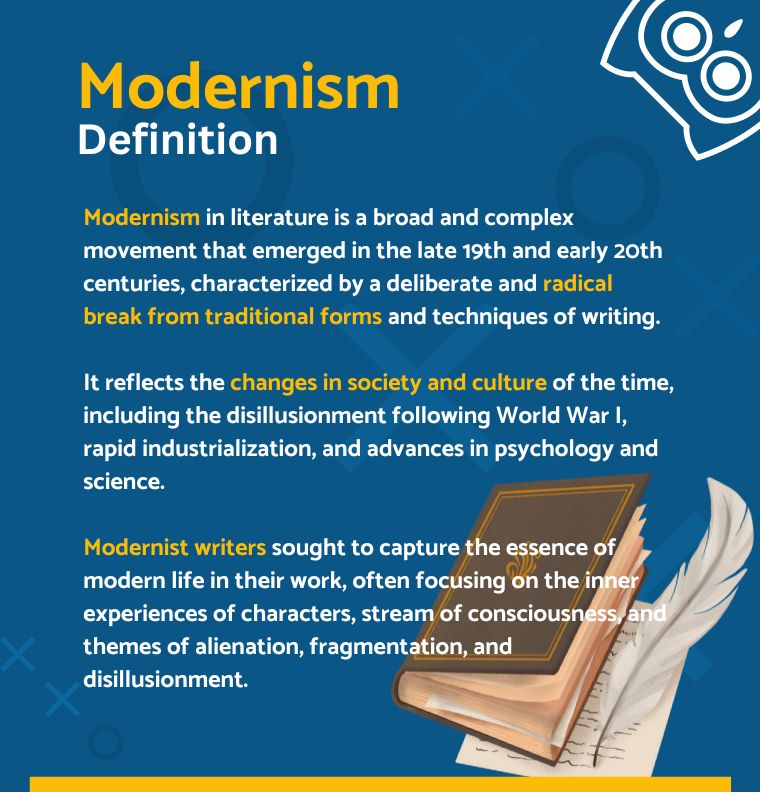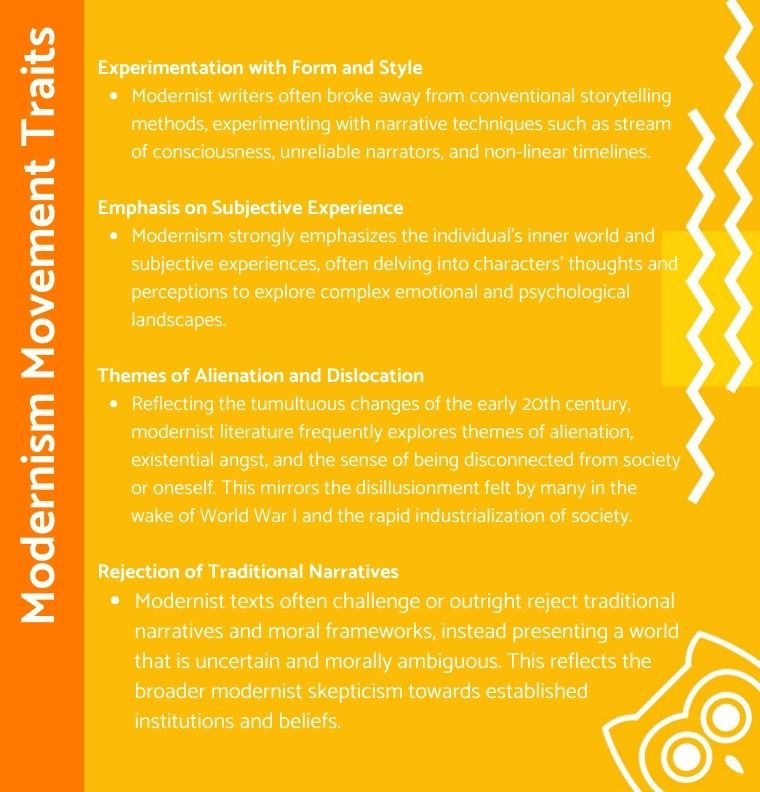What is Modernism in Literature
Table of contents
Modernism in literature refers to a broad cultural and artistic movement that emerged in the late nineteenth and early twentieth centuries in response to rapid social, technological, and intellectual change.
Rejecting traditional narrative forms and inherited literary conventions, modernist writers sought new ways to represent reality, consciousness, and human experience in an increasingly complex and fragmented world.
Key Takeaways
- Modernism in literature emerged in the late 19th and early 20th centuries as a response to profound social and historical change.
- The movement rejected traditional realism in favor of experimental forms and fragmented narratives.
- Modernist writers emphasized subjectivity, psychological depth, and inner consciousness.
- Literary innovation became a tool for representing uncertainty and instability in modern life.
- Modernism fundamentally reshaped how stories are structured, told, and interpreted.
Modernism Definition
Modernism in literature signifies a dynamic cultural shift that took root in the late 19th and early 20th centuries.
This wave of change was a direct rebuttal to the established norms of Victorian literature and the romanticized vision of nature, favoring instead a more disjointed and subjective depiction of human nature and experience.
The inception of modernism didn’t occur in isolation; it was inseparably knotted with the epoch-making transformations of its era.
The tremors of World War I had fundamentally shaken the world, and, coupled with rampant urbanization and the surge of industrialism, they started a tectonic shift in societal structures and consciousness.
These pivotal changes underpinned the collective experience, creating overwhelming disillusionment and alienation.
This societal disenchantment served as the perfect crucible for the emergence of modernism in literature. The movement encapsulated this disillusionment and estrangement, elegantly mirroring the time’s fragmented reality and subjective human experience.
The term “modernism” was more than just a literary shift; modernism was a seismograph, recording the societal shifts and human sentiments of an era of turbulent change.
So asking, “What is modernist literature?” isn’t enough as a question to understand the concept. It involves many factors, such as modernist techniques and characteristics of literary modernism.

Historical Context and the Roots of Modernism
Modernism in literature was just starting to take shape in the late 19th and early 20th centuries when writers began to seriously question the traditional ways of capturing reality.
When your world is changing—rapid industrialization, cities spreading like wildfire, and technology leaping forward by the day—it is bound to shake things up. Suddenly, old certainties about stability, morality, and personal identity no longer felt reliable.
Then the First World War came along and blew all that to smithereens.
The sheer scale of destruction was unlike anything seen before. It shattered illusions about the world as a rational, orderly place. It is no surprise that literature began to reflect this collapse.
Writers started to abandon the objective “tell and show” style and turned instead to thoughts, emotions, and personal experience.
Reality felt fragmented and uncertain—exactly how life felt at the time.
New ideas were also emerging. Psychoanalysis began probing the unconscious mind, while philosophy questioned whether truth was fixed at all.
For modernist writers, this marked a turning point. Straight-line plots and straightforward storytelling no longer felt adequate. They began experimenting with form, language, and point of view to capture the complexity of modern life.
The fragmented and ambiguous nature of modernist literature was not accidental.
It was a direct response to a world that no longer made sense.
At the same time, this radical break with tradition becomes clearer when modernism is viewed alongside earlier literary models that emphasized order, morality, and cyclical patterns of human life.
Comparing modernist experimentation with classical works such as Hesiod’s Works and Days summary helps highlight just how sharply modernist writers departed from ancient ideas of structure, harmony, and meaning.
Characteristics of Modernism in Literature
As a revolutionary movement, modernist works introduced various novel techniques and thematic concerns that challenged traditional literary norms. The following are some of the most significant characteristics of the modernist period that define this influential period in literary history.

Rejection of Traditional Forms and Conventions
Modernist literature marked a revolutionary, conscious break from conventional literary methods. It vehemently dismissed the structured composition, ethical absolutes, and elaborate language that were hallmarks of Victorian literature.
Modernist authors chose to mirror their age’s mess and fragmented reality, purposefully disrupting and upending entrenched norms. This shift wasn’t merely about moving away from the past but a purposeful leap into the uncharted territories of literary expression.
Experimentation with Narrative Structure and Style
One of the defining features of literary modernism is its inventive manipulation of form. Many writers fearlessly experimented with stream-of-consciousness narrative, a technique that attempts to simulate human thoughts’ free-flowing and non-linear nature.
They also embraced innovative structures, such as fragmented narratives and polyphonic perspectives, which magnified their works’ intricacy and depth.
Focus on Subjective Experiences and Interiority
Literary modernism bore a significant focus on the internal world of characters. It dismissed the external, observable world in favor of the subjective and introspective, putting a magnifying glass on characters’ perceptions and mental states in the short story rather than prioritizing the storyline.
This shift in focus emphasized the complexity of individual perception as authors sought to navigate the labyrinth of the human mind.
Fragmentation and Nonlinear Storytelling
Modernist works often eschew the orderly progression of linear narratives, reflecting the fragmented, disjointed reality of the early modernists’ era instead. The storyline is frequently fractured, disrupted, or intentionally made challenging to follow.
This narrative style underscores the themes of uncertainty and dislocation pervasive during the first modernist period, skillfully translating societal disruption into a narrative form.
Emphasis on Individualism and Self-expression
The individual’s experience takes center stage in many modernist writers’ works.
In short stories, writers amplified the characters’ autonomy and self-expression, frequently set against restrictive societal norms or cataclysmic events. This emphasis on individual experience was a narrative choice and a bold statement on the value and complexity of personal perspectives in a rapidly changing world.
Literary modernism represented a daring shift in how writers perceived the world and human experience. Its innovative narrative techniques and focus on the subjective experience offered a fresh lens to examine reality, one that continues to shape and influence literature today.
Modernist literature was more than just a movement; it was a profound, deeply felt response to an era of enormous change and upheaval. As outlined above, modernism’s five traits and characteristics can only begin to touch upon the rich, multifaceted world of literary movements—a world that continues to inspire and provoke us to this day.
Major Themes in Modernist Literature
Modernist literature, with its innovative techniques, literary devices, and unconventional narratives, is marked by several recurrent themes reflecting its time’s societal transformations. Exploring these key modernist themes also offers a deeper understanding of the modernist movement’s spirit and lasting impact on literary history.
Alienation and Disillusionment
A dominating theme in literary modernism is the deep sense of alienation and disillusionment. This sentiment mirrors the rough societal shift and profound distrust in institutions that marked the era. Characters in modernist works often grapple with feelings of detachment and rootlessness, reflecting a sense of being adrift in a society that seems increasingly remote and impersonal.
They are typically dissatisfied with the societal norms and structures, caught in a world that has moved away from the traditional values they once held dear. This results in an acute sense of isolation as they try to find meaning and purpose in an evolving world that feels strange and disturbing.
Loss of Faith and Existential Angst
Another recurring theme in modernist literature is the loss of faith and the resulting existential angst. Characters often wrestle with a crisis of belief, which could be religious, ideological, or both.
This crisis leads many modernists and writers to deep existential angst, a fear of the lack of defined purpose or meaning in life. This existential dread is often portrayed through characters questioning their existence, societal roles, and the larger purpose of life and human existence. They grapple with profound uncertainties, their disillusionment leading to a rejection of previously accepted beliefs and values.
Stream of Consciousness and Inner Thoughts
The stream-of-consciousness narrative technique, widely employed by modernist writers, was an innovative attempt to depict the uninterrupted, often chaotic, flow of characters’ inner thoughts and feelings.
This style provided a more intimate peek into the mental landscape of characters, offering readers a sense of the complexities and contradictions that often lie beneath surface behavior. The intricate interplay of thoughts, memories, feelings, and reflections helped create more human, flawed, and relatable characters.
Ambiguity and Uncertainty
Modernist literature is characterized by intentional ambiguity and uncertainty. These works often lack a clear moral center, mirroring the perceived absence of absolute truth in a rapidly evolving society.
They challenge the reader to navigate the moral and interpretative ambiguity, offering multiple perspectives, fragmented narratives, and open-ended conclusions. This characteristic of modernist literature underscores the inherent uncertainty of life, reflecting the complex, multi-layered realities of a changing world.
Critique of Societal Norms and Values
Modernist literature didn’t shy away from critiquing its time’s dominant societal norms and values. The works often challenged ingrained conventions related to gender roles, class hierarchies, morality, and other societal structures. Modernist authors boldly deconstructed traditional notions and presented alternate perspectives, forcing readers to question and rethink long-held beliefs.
They scrutinized societal norms’ inequities, hypocrisies, and underbelly, inspiring introspection and debate about the essence of morality, the fluidity of gender roles, and the societal constraints that limit individual freedom. This critique made modernist literature a powerful platform for social commentary, mirroring and challenging the world it emerged from.
10 Modernist Writers in the Literary Movement
As we journey through the intricate landscape of the modernist literary movement, certain names shine brightly, their contributions serving as pillars of this transformative epoch in English literature.
Let us delve into the short stories and profiles of these influential modernist poets and writers, each leaving an indelible mark on literature through their unique and groundbreaking works.
James Joyce
Emerging from Ireland’s rich literary tradition, James Joyce occupies a central place in twentieth-century modernist literature.
His major works, including Ulysses and Finnegans Wake, pushed narrative form to its limits through complex structure, linguistic experimentation, and the innovative use of stream of consciousness. Joyce’s writing challenged conventional storytelling and permanently altered how narrative time, consciousness, and language could function in fiction.
Virginia Woolf
A key figure in literary modernism, Virginia Woolf transformed narrative structure by focusing on inner experience rather than external action.
In novels such as Mrs. Dalloway and To the Lighthouse, she explored memory, perception, gender, and psychological depth. Her fluid prose and experimental form reflect the shifting consciousness of the modern world and remain influential in contemporary fiction.
T. S. Eliot
Born in the United States but closely associated with British literary culture, T. S. Eliot is one of the most influential modernist poets.
His poem The Waste Land is widely regarded as a defining modernist text. Through fragmentation, dense symbolism, and literary allusion, Eliot captured the spiritual dislocation and cultural uncertainty of postwar society.
Ernest Hemingway
Ernest Hemingway is known for his restrained, minimalist prose, which marked a sharp departure from earlier literary styles. Works such as The Sun Also Rises and A Farewell to Arms rely on sparse language, dialogue, and action. His “iceberg theory” left much unsaid, encouraging readers to infer meaning beneath the surface of the text.
F. Scott Fitzgerald
F. Scott Fitzgerald is closely associated with the cultural atmosphere of the Jazz Age. His novel The Great Gatsby stands as one of the most recognizable works of modernist literature. Through themes of disillusionment, excess, and the pursuit of the American Dream, Fitzgerald captured the contradictions and anxieties of his generation.
Franz Kafka
Franz Kafka’s fiction explores alienation, anxiety, and the absurdity of modern existence. Works such as The Metamorphosis and The Trial portray individuals trapped within incomprehensible systems of power and guilt. His unsettling narratives reflect the existential uncertainty at the heart of modernist thought.
Marcel Proust
Marcel Proust’s multi-volume novel In Search of Lost Time is renowned for its deep exploration of memory and perception. Through extended introspection and detailed psychological observation, Proust reshaped narrative time. His work exemplifies the modernist focus on subjective experience and inner reality.
William Faulkner
William Faulkner’s novels, particularly The Sound and the Fury, are known for their complex narrative structures and shifting perspectives.
His use of nonlinear timelines and multiple voices reflects modernism’s interest in fragmented consciousness and the instability of truth. Faulkner’s work significantly influenced twentieth-century American literature.
D. H. Lawrence
Often associated with modernism, D. H. Lawrence challenged social conventions by openly exploring human instincts, emotional relationships, and sexuality. Novels such as Lady Chatterley’s Lover confronted moral norms and provoked controversy. His work emphasized the conflict between industrial society and human desire.
Ezra Pound
Ezra Pound played a crucial role in shaping modernist poetry. Through works like The Cantos and his promotion of imagism and free verse, he encouraged precision, economy of language, and formal experimentation. Pound’s influence extended beyond his own writing, shaping the development of modernist poetry as a whole.
Criticisms and Challenges to Modernism
Although modernism has had a profound influence on literature, it has also faced consistent criticism. One of the main objections concerns its experimental techniques and style, which many readers find difficult to follow.
Complex structures, fragmented narratives, and stream-of-consciousness writing can make modernist works feel inaccessible, particularly to less experienced readers.
Another common critique targets modernism’s strong emphasis on individualism and introspection.
Critics argue that modernist literature often prioritizes personal consciousness and subjective experience at the expense of broader social concerns. This inward focus has led some to view the movement as self-indulgent or elitist, detached from collective realities and everyday social issues.
Modernism has also been criticized for its Western-centered perspective.
Much of the movement developed in response to social and cultural changes in Europe and North America, which resulted in limited representation of non-Western voices. As a result, critics argue that modernism often overlooks the experiences of marginalized communities and lacks cultural inclusivity.
The rise of postmodernism in the mid-twentieth century further challenged modernist principles.
Postmodern writers rejected the idea of unified meaning and singular truth that underpinned much modernist thought. Instead, they emphasized fragmentation, irony, and the idea that reality is constructed and context-dependent rather than universal.
Finally, some critics argue that modernism’s constant drive for innovation created a break with literary tradition that can feel disorienting.
In rejecting established forms, modernist writers sometimes dismissed the value of earlier literary practices and the continuity they provide.
Despite these criticisms, modernism remains a defining force in literary history. The debates surrounding its limitations and contradictions continue to shape discussions about literature, ensuring that modernism remains a subject of ongoing critical engagement.
Impact of Modernism
Modernism had a lasting impact on literature and the arts that continues to influence creative work today. The movement challenged traditional forms, questioned established norms, and opened a new period of artistic experimentation.
This spirit of innovation, central to the themes and techniques of modernism in literature, expanded the possibilities of artistic expression and reshaped creative boundaries.
This break with tradition appeared most clearly in literature. Linear narratives were dismantled in favor of psychological introspection and fragmented perspectives.
Writers such as James Joyce and Virginia Woolf popularized the stream-of-consciousness technique, allowing readers direct access to their characters’ inner thoughts. This shift encouraged a deeper exploration of human consciousness, a focus that remains central to much contemporary literature.
Modernism also influenced other artistic disciplines.
In visual art, painters like Pablo Picasso and Wassily Kandinsky moved away from realistic representation toward abstraction and expressionism. Their work reflected the same modernist impulse to challenge perception and reject conventional forms.
In architecture, modernism emphasized functionality and simplicity over ornamentation. Buildings such as Le Corbusier’s Villa Savoye and Mies van der Rohe’s Barcelona Pavilion illustrate the principle that form should follow function, an approach that continues to shape modern architectural design.
Modernist music followed a similar path. Composers like Igor Stravinsky and Arnold Schoenberg experimented with new musical structures, including atonality and complex rhythms, pushing beyond traditional harmonic systems.
Overall, modernism reshaped creative expression across disciplines. Its influence remains visible in literary experimentation, abstract visual art, functional architectural design, and innovative musical composition.
In literature, modernist techniques such as fragmented narration and interior monologue continue to shape contemporary novels that focus on subjective experience and psychological depth.
Bottom Line
In essence, the elements of modernism in literature revolutionized literary expression by introducing deeper psychological exploration, innovative narrative techniques, and a clear break from traditional literary norms.
While the movement is not without criticism, its lasting influence continues to inspire generations of writers, shaping how literary analysis is approached today—much like a well-structured writing literature review relies on critical engagement, contextual awareness, and interpretive depth.
Despite its complexities and the critiques it has received, the impact of the modernist literary movement remains undeniable. From stream-of-consciousness narration to subjective representations of reality, modernism’s influence can still be traced throughout contemporary literature, confirming its enduring relevance.







